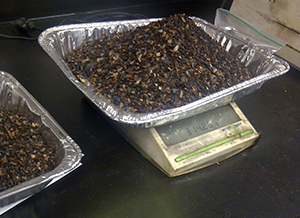Bio Coal



Bio-coal is produced using technology called torrefaction. Torrefaction is a partial carbonization process at temperatures between 475 – 575°F (200 – 400°C) in a low oxygen environment. The physical and energetic properties of the biomass are then much more comparable to conventional coal. Once the biomass goes through the torrefaction process, a bonding agent is added so it can be compressed into very dense briquettes called Bio-coal. The torrefaction process has the added benefit of reducing or eliminating undesirable volatiles, such as nitrous oxides and sulfur dioxides in the Bio-coal. Bio-coal is considered carbon neutral to the environment. The key property that makes Bio-coal attractive for co-firing in existing coal-fired power stations is its superior grind ability compared to untreated or fresh biomass. After torrefaction, biomass has lost its tenacious nature and some of its fibrous structure.
Benefits of Bio-Coal:
• Bio-coal is comparable in price to conventional coal.
• Bio-coal is made from renewable sources. Oil and coal cannot be replaced.
• Bio-coal contains no sulfur. Oil and coal have high sulfur content and when burned, pollute the environment.
• Bio-coal has a higher practical thermal value and much lower ash content compared to conventional coal.
• There is no fly ash when burning Bio-coal.
• Bio-coal has consistent quality, higher burning efficiency, and is the ideal size for complete combustion.
• Combustion from Bio-coal is more uniform compared to conventional coal and boiler response to changes in steam requirements is faster with Bio-coal due to the higher quantity of volatile matter.
• Bio-coal is easy to store and hygienic to handle.
Process Energy Balance of Bio-Coal:
During the torrefaction process approximately 70% of the mass is retained as a solid product containing 90% of the initial energy content. The remaining 30% of the mass is converted into torrefaction gases, but contains only 10% of the energy content of the biomass. Hence, considerable energy density can be achieved, typically by a factor of 1.3 on a mass basis. This is one of the fundamental advantages of the torrefaction process, which is the high transition of the chemical energy from the timber waste to the final Bio-coal product, thus improving its fuel properties. The torrefaction gasses are then used for drying additional raw biomass before it enters the plant.
What is Biomass?
Biomass is material derived from recently living organisms. This includes plants, animals and their by-products. For example, timber waste, manure, garden waste, and crop residues are all sources of biomass.
Biomass is a renewable energy source based on the carbon cycle, unlike other natural resources such as petroleum, coal, and nuclear fuels.
Bio-coal is made primarily from timber waste, a bi-product from saw mills, lumber yards, and agricultural waste after harvest. Millions of metric tons of saw dust is produced by sawmills and lumber yards when producing wood. Approximately eighty percent of the saw dust cannot be used in products such as roof shingles and wood panels because the saw dust is too fine or not the right fiber content. This green-energy waste product can be used in the manufacturing of Bio-coal, using the torrefaction process.
